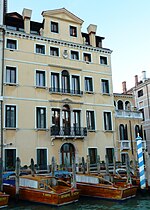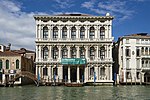Palazzo Giustinian
Gothic architecture in VeniceHouse of GiustinianiHouses completed in the 15th centuryPalaces in Sestiere DorsoduroPalaces on the Grand Canal (Venice) ... and 1 more
Venetian Gothic architecture

The Palazzo Giustinian is a palace in Venice, northern Italy, situated in the Dorsoduro district and overlooking the Grand Canal next to Ca' Foscari. It is among the best examples of the late Venetian Gothic and was the final residence of Princess Louise of Artois.
Excerpt from the Wikipedia article Palazzo Giustinian (License: CC BY-SA 3.0, Authors, Images).Palazzo Giustinian
Calle Giustinian, Mestre Venezia-Murano-Burano
Geographical coordinates (GPS) Address Nearby Places Show on map
Geographical coordinates (GPS)
| Latitude | Longitude |
|---|---|
| N 45.4345 ° | E 12.3266 ° |
Address
Ca' Foscari
Calle Giustinian
30170 Mestre, Venezia-Murano-Burano
Veneto, Italy
Open on Google Maps











